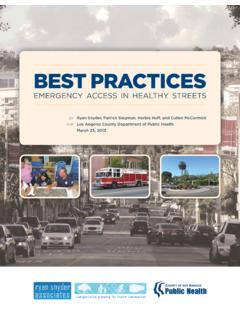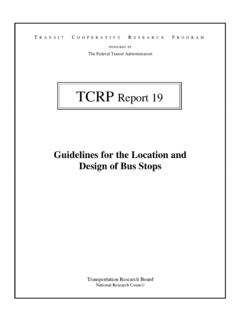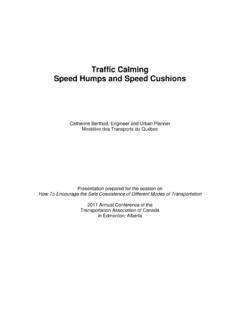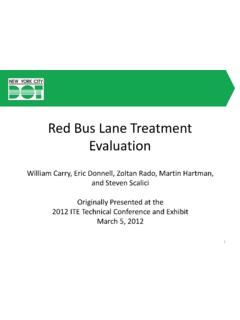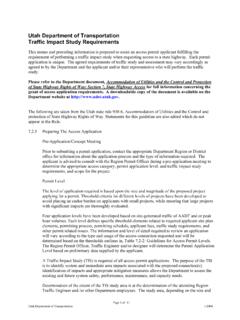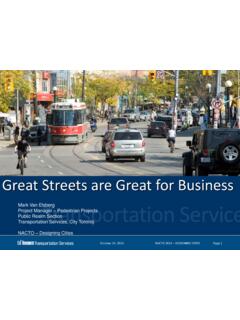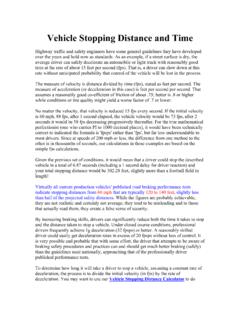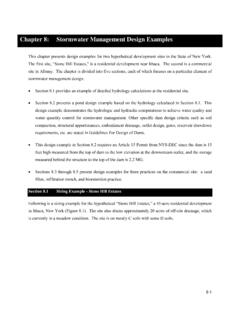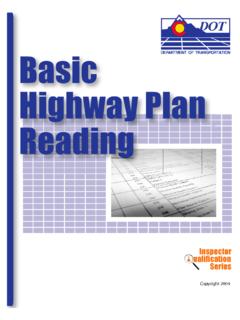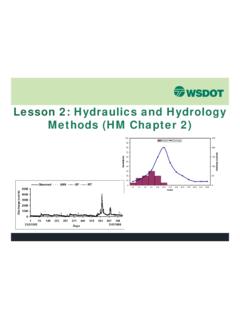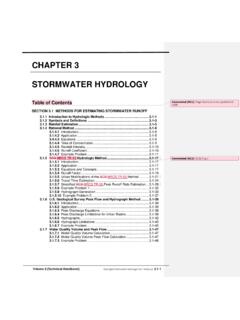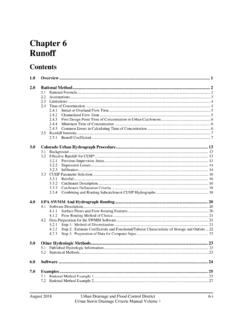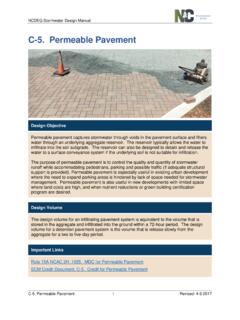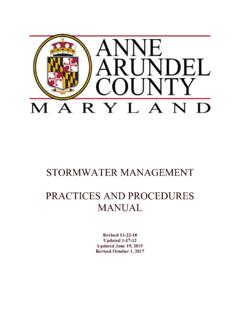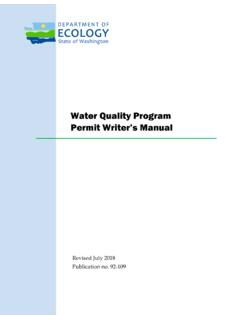Transcription of CHAPTER GUIDE: 6.0 STREETSCAPE ELEMENTS
1 Trees and landscaping, lighting, pedestrian furnishings, paving, and other ELEMENTS fi ll the spaces of the STREETSCAPE with life, light, color, and texture and make a street a comfortable, interesting, and usable space for people. GUIDE: STREETSCAPE Urban stormwater management Paving Site Utilities and DrivewaysStreetscape ELEMENTS are those functional and aesthetic items in pedestrian spaces that provide amenity and utility to pedestrians and other street ELEMENTS discussed in this CHAPTER include:Urban Forest: All plantings in the right-of-way, including street trees, understory planting (ground landscaping), and above-ground planting (planter boxes and hanging baskets) stormwater management Tools.
2 Plantings, permeable paving, and other facilities to detain and infi ltrate stormwaterLighting: Both roadway and pedestrian lighting, including poles and fi xtures, and light qualityPaving: Standard materials as well as special paving treatementsSite Furnishings: Other pedestrian amenities and functional ELEMENTS , including: benches and seating, bicycle racks, bollards, fl owerstands, kiosks and gateway monuments, newsracks, parking meters, public art, sidewalk restrooms, traffi c and parking signs, trash receptacles, and wayfi nding signageUtilities and Driveways: Overhead, surface-mounted, and sub-surface utilities including all poles, trenches, boxes, vaults, vents, and valves, and driveways to access | BETTER STREETS PLANCHAPTER 6: STREETSCAPE ELEMENTS160 Moraga AvenueTh e urban forest includes any landscaping planted in the public right-of-way, including trees, understory plantings, and above-ground plantings.
3 Planting in the public right-of-way enhances the physical, ecological, and cultural aspects of the city, includ-ing:Environmental: Trees and landscaping make important contributions to the urban environment by reducing air pollution, ameliorating urban heat islands, improving hydrologic conditions, sequester-ing carbon, and contributing to wildlife : Trees and landscaping increase property values and can reduce maintenance costs of other STREETSCAPE : Th e visual characteristics of street trees and landscaping (form, color, texture) add greatly to the aesthetics of urban streets and can enhance the civic qualities of the public : People derive psychological benefi ts from the symbolic and actual contact with na-ture provided by a green environment.
4 A planted STREETSCAPE provides relief from an otherwise built out urban : Opportunities for new social contacts, com-munity identity, and the opportunity to contribute to the establishment and care of a community feature, are aff orded by the presence of street trees and : Consistent tree plantings along a street narrow the perceived width of a street, encouraging decreased vehicular speed and increased awareness of pedestrians. Th e following section provides general principles that should guide how the City considers its urban forest, which includes all trees and landscaping.
5 Recommendations for street trees and landscaping ELEMENTS are provided in specifi c forest guidance will be further elabo-rated in the forthcoming Urban Forest IN THIS SECTION:URBAN FORESTS treet treesUnderstory landscapingAbove-ground plantingsCHAPTER STREETS PLAN |161 Many existing sidewalks can be retrofi t to include simple but attractive planting areasGuidelinesConsidering the Existing StreetscapeTrees and/or other landscaping should be added to existing side-walks wherever existing width is suffi cient to accommodate plant growth and recommended throughway widths per Section New street trees or landscaping should not result in an unob-structed sidewalk width of less than 48 inches on any in relation to street parking along streets.
6 Trees and landscaping should be kept out of the Edge Zone to protect them from car doors and overhangs and allow pedestrians to access their vehicles without confl ict. In certain instances, street trees can be placed in the parking lane in-between parking stalls if sidewalk width is not suffi cient or if a double row of trees is desired. See Section : Parking Lane adjacent to corners: When locating trees or landscap-ing in the sidewalk area near corners, they should be so located to assure visibility of traffi c signals or signs. Trees should not be placed within 5 feet of the corner property line.
7 Trees within 25 feet of corners should be pruned to 14 feet in : Careful siting of trees and landscaping around existing above and below-grade utilities is guidelines for sidewalk element clearance from street trees (not ground landscaping) on a public sidewalk are:Utility Boxes: 3 Feet Sewers: 5 Feet Fire Hydrants: 5 Feet Parking Meters: 3 FeetSidewalk Furniture: 3 Feet Utility Poles: 5 FeetGas and water meter and mains: 5 FeetTrees should be planted a minimum of 2 feet from the face of the curb. CHAPTER | BETTER STREETS PLANCHAPTER 6: STREETSCAPE ELEMENTS162 Appropriate setbacks from specifi c ELEMENTS for of diff erent sizes, colors, and types adds rich variety to the Plant TypesStreet trees and other landscaping should be used to create a dis-tinct character for specifi c streets and neighborhoods.
8 Trees and landscaping should be designed in harmony with street light-ing and sidewalk amenities and the building context. Trees and plants vary in their aesthetic appearance due to form, texture, foliar density/visual permeability, seasonal presence of fl owers, growing season color, fall color, bark characteristics, and persis-tence of leaves (evergreen vs. deciduous). Aesthetic appearance should be taken into account in making design decisions for the public right-of-way. New planting added to existing streets should be in visual harmony with existing trees and planting. Selection of planting material should be used to enhance the identity of particular view of global climate change, consideration should be given to future watering needs and heat resistance of species selected for planting.
9 Landscape practices should follow xeriscape prin-ciples and drought-tolerant species should be used to meet the increased dryness associated with the anticipated future climate of San material selection should account for performance in the urban environment, including drought tolerance and hardiness. Unfortunately, many native species do not do well in harsh urban conditions. Any plant species selected for planting should be adapted to soil and microclimate conditions and should serve an intended functional or aesthetic role. In some cases, the drought tolerant character of some native species may make them particu-larly suited for planting; however, past performance of the species in terms of durability, longevity, wind resistance, high branching to provide line-of-sight for pedestrians and vehicles must also be considered.
10 Native plants and trees should be used when a na-tive species is suited to the site and will serve the roles for which the planting is intended generally. for stormwater plantings, ar-eas of habitat value or connections, or for educational tree species should be used where it is desired to main-tain foliage through the winter months or to enhance ecological performance by allowing leaves to slow stormwater during the rainier season. Deciduous trees should be considered for their ability to allow sunlight in the winter months and give shade in the summer, and for accent and SoilPlacement of trees and landscaping should refl ect an understand-ing of local soil and climate conditions.

